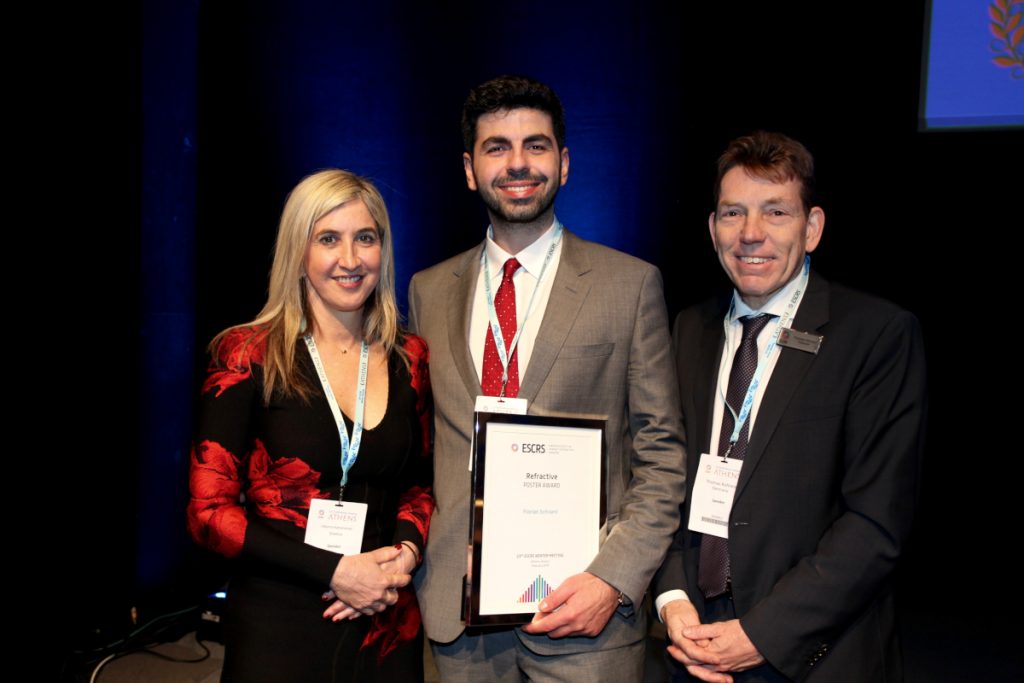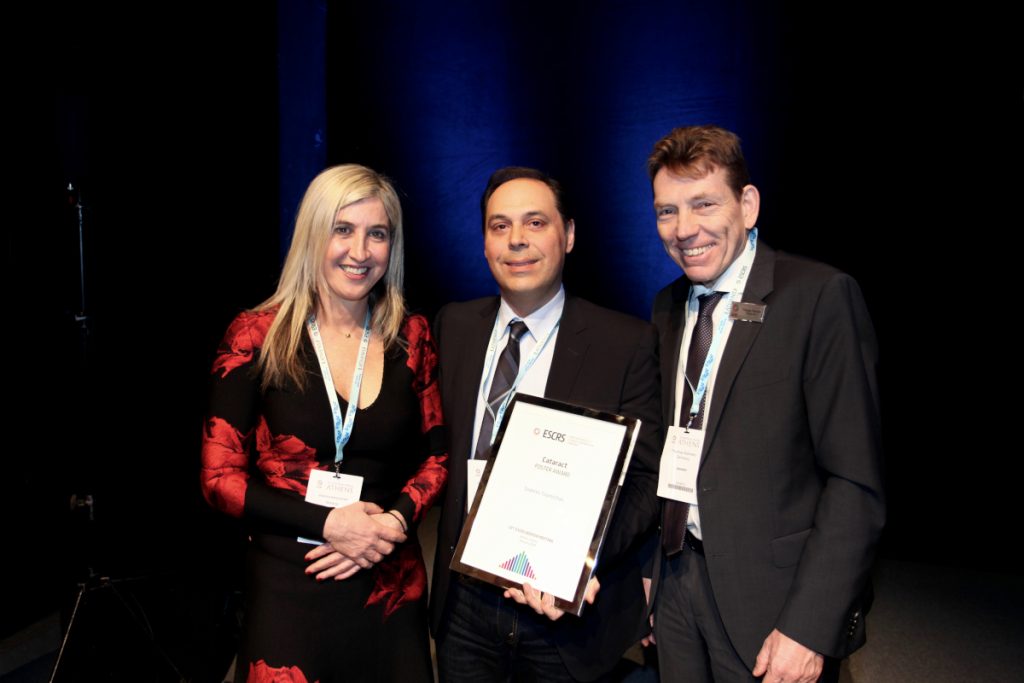Poster Prizes
Winners in 23rd ESCRS Winter Meeting competition provide new insights in secondary cataract and refractive procedures.

Roibeard O’hEineachain
Published: Wednesday, May 1, 2019
 Apostolos Lazaridis, on behalf of Florian Schraml, accepting the award for Best Refractive Poster from Vikentia Katsanevaki and Thomas Kohnen[/caption]
Studies on intraocular lens power calculation and scleral IOL fixation won the poster awards at the 23rd ESCRS Winter Meeting in Athens, Greece. The prize in the Refractive category went to Florian Schraml, Philipps University of Marburg, Germany, for “Predictability of intraocular lens power calculation after SMILE for myopia”. The poster describes a study that included 204 eyes of 105 patients, who underwent IOL implantation following small-incision lenticule extraction (SMILE®) procedures.
All eyes underwent preoperative evaluation with the IOLMaster® 500 (Carl Zeiss Meditec) and corneal tomography using Pentacam HR (Oculus). At three months’ follow-up Dr Schraml and his associates compared the difference between the predicted preoperative and postoperative IOL power – as predicted by ray tracing using Oculogix software, and third- and fourth-generation IOL calculation formulas – and the change of sphere as determined by manifest refraction.
They found that the IOL power difference as predicted with ray tracing and the fourth-generation Haigis L formula showed no significant differences compared to the change of sphere. In contrast, the IOL power difference as predicted with all other formulas showed significant difference compared to the sphere difference. Moreover, the prediction error was significantly smaller with ray tracing compared to the third- and fourth-generation formulas.
“Ray tracing takes into consideration the true shape of the cornea after refractive surgery by using both the anterior and posterior central curvature radii and the asphericity of the surfaces. Moreover, it uses the central IOL, thickness, the index of refraction and the true geometrical position, as defined by the anterior chamber depth, to describe the IOL and calculate its power more accurately,” Dr Schraml concluded.
[caption id="attachment_14058" align="alignleft" width="1024"]
Apostolos Lazaridis, on behalf of Florian Schraml, accepting the award for Best Refractive Poster from Vikentia Katsanevaki and Thomas Kohnen[/caption]
Studies on intraocular lens power calculation and scleral IOL fixation won the poster awards at the 23rd ESCRS Winter Meeting in Athens, Greece. The prize in the Refractive category went to Florian Schraml, Philipps University of Marburg, Germany, for “Predictability of intraocular lens power calculation after SMILE for myopia”. The poster describes a study that included 204 eyes of 105 patients, who underwent IOL implantation following small-incision lenticule extraction (SMILE®) procedures.
All eyes underwent preoperative evaluation with the IOLMaster® 500 (Carl Zeiss Meditec) and corneal tomography using Pentacam HR (Oculus). At three months’ follow-up Dr Schraml and his associates compared the difference between the predicted preoperative and postoperative IOL power – as predicted by ray tracing using Oculogix software, and third- and fourth-generation IOL calculation formulas – and the change of sphere as determined by manifest refraction.
They found that the IOL power difference as predicted with ray tracing and the fourth-generation Haigis L formula showed no significant differences compared to the change of sphere. In contrast, the IOL power difference as predicted with all other formulas showed significant difference compared to the sphere difference. Moreover, the prediction error was significantly smaller with ray tracing compared to the third- and fourth-generation formulas.
“Ray tracing takes into consideration the true shape of the cornea after refractive surgery by using both the anterior and posterior central curvature radii and the asphericity of the surfaces. Moreover, it uses the central IOL, thickness, the index of refraction and the true geometrical position, as defined by the anterior chamber depth, to describe the IOL and calculate its power more accurately,” Dr Schraml concluded.
[caption id="attachment_14058" align="alignleft" width="1024"] Ioannis Tzamichas accepting the award for Best Cataract Poster from Vikentia Katsanevaki and Thomas Kohnen[/caption]
The prize in the cataract category went to Ioannis Tzamichas, Ippokrateio General Hospital of Thessaloniki, Greece, for “Scleral fixation of dislocated 1-piece IOL without IOL explantation or intrascleral sutureless 3-piece IOL fixation: making the right surgical decision”. The poster describes a retrospective consecutive case series of 22 patients who underwent scleral IOL fixation following complicated cataract surgery owing to insufficient zonular/capsular support.
The study included seven aphakic patients who underwent transconjuctival intrascleral 25g-trocar-based sutureless fixation of a three-piece IOL. There were also 17 pseudophakic patients who underwent transscleral 9-0 polypropylene fixation of the dislocated one-piece IOL without IOL explantation.
At a mean follow-up of approximately one year, mean visual acuity improved from hand movements to 0.8 among the seven aphakic patients, and from 0.05 to 0.63 among 17 pseudophakes with dislocated IOLs. There were no major ocular complications in either group.
“Our proposed surgical methods depend on patients’ phakic status, and are safe and have favourable visual outcomes. Both procedures are time- and cost-efficient, a non-negligible factor taking into account the financial crisis in Greece that has dramatically affected public healthcare services,” Dr Tzamichas concluded.
Ioannis Tzamichas accepting the award for Best Cataract Poster from Vikentia Katsanevaki and Thomas Kohnen[/caption]
The prize in the cataract category went to Ioannis Tzamichas, Ippokrateio General Hospital of Thessaloniki, Greece, for “Scleral fixation of dislocated 1-piece IOL without IOL explantation or intrascleral sutureless 3-piece IOL fixation: making the right surgical decision”. The poster describes a retrospective consecutive case series of 22 patients who underwent scleral IOL fixation following complicated cataract surgery owing to insufficient zonular/capsular support.
The study included seven aphakic patients who underwent transconjuctival intrascleral 25g-trocar-based sutureless fixation of a three-piece IOL. There were also 17 pseudophakic patients who underwent transscleral 9-0 polypropylene fixation of the dislocated one-piece IOL without IOL explantation.
At a mean follow-up of approximately one year, mean visual acuity improved from hand movements to 0.8 among the seven aphakic patients, and from 0.05 to 0.63 among 17 pseudophakes with dislocated IOLs. There were no major ocular complications in either group.
“Our proposed surgical methods depend on patients’ phakic status, and are safe and have favourable visual outcomes. Both procedures are time- and cost-efficient, a non-negligible factor taking into account the financial crisis in Greece that has dramatically affected public healthcare services,” Dr Tzamichas concluded.